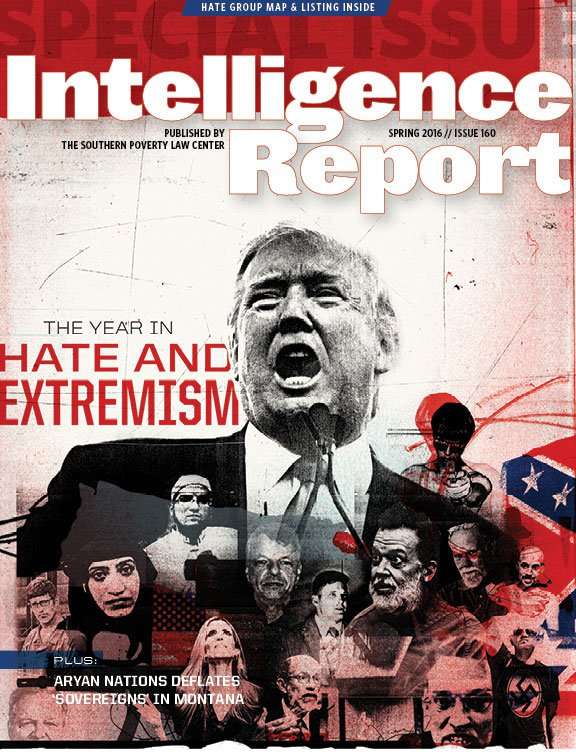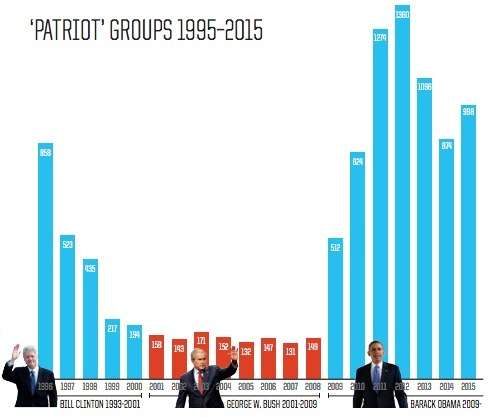The Southern Poverty Law Center Strikes Again
What should we make of the SPLC's annual count of "hate groups" and "anti-government groups"?

The Southern Poverty Law Center has published its annual report on "The Year in Hate and Extremism," which as always includes its attempt to tally how many hate groups and how many anti-government "Patriot" groups exist in America. This year, both figures rose about 14 percent.
I have repeatedly made two criticisms of these counts and the ways they're used. One problem is built in to the idea of measuring a movement's strength by counting the number of groups on the ground. If an organization splinters, that suggests it's getting weaker, but on these lists the disarray will show up as growth. The SPLC's Mark Potok more or less acknowledges this problem in his write-up of the numbers this year. The "hardest core sectors of the white supremacist movement—white nationalists, neo-Nazis and racist skinheads—actually declined somewhat," he notes, with the hate-group count going up because there are more Klan groups and black separatist organizations. But the Klan spike is "probably mainly accounted for" by the fact that two large Klans fell apart last year, leaving their adrift former members to form new grouplets.
I don't doubt that there's been some genuine growth in some of these movements. It's plausible, for example, that the general recent increase in civil rights activism would include some growth on the separatist fringes. And Potok may be right that the outcome of the original Bundy standoff led more people to join militia-style groups. But the numbers being thrown around can be misleading.

That's especially true when you run into my other recurring complaint—that people try to treat these lists as a proxy for the number of Americans willing to engage in right-wing terrorism. The problem is that they include nonviolent as well as violent organizations. (This year's list of anti-government groups, for example, includes 44 chapters of Phyllis Schlafly's Eagle Forum, 24 chapters of the John Birch Society, a separate listing for "the John Birch Society Shop," and the paleolibertarian website LewRockwell.com.) Nonviolent groups can be a stepping-stone to violence, but they can also pull people away from violence; in several cases, nonviolent activists have even turned would-be terrorists in. Potok never tries to account for those dynamics.
The SPLC does caution against using the list as a proxy for the terror threat in another, more self-serving way. Before this latest report came out, we saw several years in which its numbers of hate groups and anti-government groups were both declining. So the center took to playing up the specter of unorganized "lone wolf" violence, noting that such crimes can surge even as actual groups disappear. This year Potok combines the approaches, citing the increasing number of groups while also highlighting the threat of the loners.
So how much lone-wolf terror was there in 2015? The SPLC turns to another organization for its answer:
According to a year-end report from the Anti-Defamation League (ADL), "domestic extremist killers" slew more people in 2015 than in any year since 1995, when the Oklahoma City bombing left 168 men, women and children dead. Counting both political and other violence from extremists, the ADL said "a minimum of 52 people in the United States were killed by adherents of domestic extremist movement[s] in the past 12 months."
If that number seems extraordinarily high, it's because of that phrase "and other" sitting there between "political" and "violence." The ADL's count includes gang slayings, domestic violence, and other apolitical or ambiguous assaults in which the killer also happens to subscribe to an "extremist" worldview. According to the ADL's bulletin, the number of ideologically motivated murders last year was not 52 but 34. That breaks down to 19 deaths in two Islamist attacks (the mass shootings in Chattanooga and San Bernardino) and 15 killings by people with views resembling the groups covered in the SPLC's lists, with the grisliest incident being the massacre of nine Charleston churchgoers in June. This may be more than usual, especially on the Islamist front, but it's within the sort of random year-to-year fluctuations that you often see with rare crimes.
If you want to read the SPLC's full report, it's here. For a different view of the year that just ended, read my "2015: The Year in Fear."